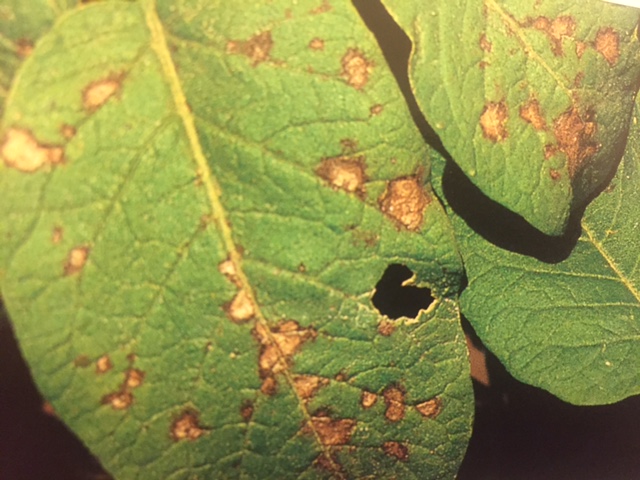Early blight is a fungal disease that targets tomatoes in particular but also hits potatoes, peppers, and eggplant.
Early blight can infect plants at almost any time during the growing season. It is most prevalent in regions where there is high humidity and when temperatures are greater than 75°F.
Fungal spores carrying the disease are spread on the wind or by insects. Spores germinate and grow when plants are moist from heavy dew or frequent rain.
Disease range: United States and Canada; severe in humid regions, Midwest, humid eastern states.
Scientific name: Alternaria solani
Good Products for Pest and Disease Control at Amazon:
- Garden Safe Snail and Slug Bait
- Bonide Sulfur Fungicide
- Monterey BT Caterpillar Killer
- Neem Bliss 100-% Cold Pressed Neem Oil
- Safer Brand Insect Killing Soap
- PyGanic Botanical Insecticide
Early blight target plants
Early blight attacks tomato, eggplant, and pepper plants and weeds in the tomato or nightshade family.

Early blight damage
Leaves
Early blight symptoms appear first on older, mature leaves near the base of the plant. One or two irregular spots appear on each leaf. The spots are ¼ to ½ inch in diameter. The spots have tan centers with concentrically ridged rings and yellow halos around the edges–a target-shape appearance with defined borders. The spots enlarge and coalesce. A large portion of the leaf becomes a diffuse yellow and may drop. No mold appears. The disease spreads slowly.
Stems
Early blight appears as dark, sunken lesions at or above the soil line of stems. This is sometimes called collar rot.
Fruits of tomato, eggplant, and pepper
Early blight appears as sunken spots on the stem end of fruits tomatoes, eggplants, and peppers. A concentric ring pattern or target-shape appearance appears around spots. The disease moves from the stem to rot the fruit.
Tubers of potatoes
Early blight potato tuber lesions are brown or black sunken spots less than ½ inch wide.
How early blight spreads
Early blight fungi spores are wind- and rain-borne. Sometimes the disease can be transmitted by flea beetles who have fed on diseased plants. Hyphae enters the plant through cracks and wounds in plant tissue.
Early blight life cycle
Early blight fungi overwinter on decomposed plant debris and form new spores each spring. Several generations of spores can occur during summer when the disease is widespread.
Early blight organic controls and prevention
Here are ways to prevent and control early blight:
- Use seed potatoes certified disease free.
- Plant disease-resistant varieties; long-season potato varieties are the most resistant.
- Do not plant tomatoes and potatoes close together to prevent cross-infection.
- Rotate tomato and potato crops that do not get early blight.
- Avoid overhead watering.
- Space and thin to allow light and air to reach plants.
- Space potatoes widely.
- Stake or cage tomatoes, eggplants, and peppers.
- Keep plants healthy; side-dress plants with a balanced fertilizer.
- Remove infected leaves from plants as soon as you see them.
- Mulch around plants to prevent fungal spores from splashing onto plants.
- Spray plants with compost tea or Bacillus subtilis to prevent blight from spreading.
- Keep the garden free of dropped or diseased plant material during the growing season.
- Clean the garden of all plant debris at the end of the season.
- Eliminate tomato family weeds such as black nightshade that can harbor fungal spores.
Early blight non-organic controls
Drench soil with Trichoderma harzianum at planting time. Spray with a fungicide containing chlorothalonil. Consult your nearby cooperative extension for regionally-approved fungicides.
General prevention of fungal diseases
- Remove diseased leave as soon as they appear.
- Improve air circulation around plants.
- Mulch around the base of plants to reduce water splashing.
- Do not use overhead watering.
- Control weeds.
- Rotate crops.
Related articles:
Vegetable Garden Diseases Problem Solver
Vegetable Garden Organic Weed Control
Vegetable Garden Organic Pest Control
Garden Planning Books at Amazon:
- Vegetable Garden Almanac & Planner
- Kitchen Garden Grower’s Guide Vegetable Encyclopedia
- Vegetable Garden Grower’s Guide
- Tomato Grower’s Answer Book















